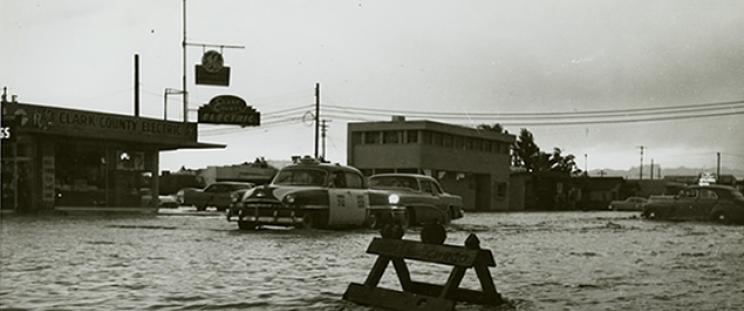Collection Paragraphs

“Whatever man may do, nature will proceed uninterruptedly in its course . . ”
Captain George M. Wheeler, Geographical Surveys West of the One Hundredth Meridian, 1889
Inquiry:
Using resources in this collection and the book Cadillac Desert, do you feel Wheeler's comment is substantiated?
The problem with water in the desert is not always its scarcity, but sometimes the floods caused when it does rain. The hardpan, or caliche as it is known, is pervasive in the Las Vegas Valley. Caliche forms in both fine-grained and course-grained soil. Calcium carbonate accumulates under the surface in areas where evaporation exceeds precipitation, particularly in deserts. The calcium carbonate becomes cemented, creating a rock-like, impermeable layer which, when combined with other geological features, keeps much of the rainwater on the surface.

It does rain in Southern Nevada, but infrequently. When rain falls, the thin soil saturates quickly, funneling the runoff into gullies, washes, and streams. Flash flooding can turn a dry streambed into a raging torrent, destroying everything in its path including railroad tracks; the Salt Lake line was washed out on a number of occasions and at a number of locations. The lack of anchoring vegetation combined with large amounts of water can produce significant erosion, which human activity can exacerbate by disturbing soils and unintentionally redirecting floodwaters to places where there is no underlying hardpan.
Blocking the natural water courses of drainage in the valley by construction and urban development has worsened flooding, causing recurring and severe damage in the city of Las Vegas. Today, a regional flood control program utilizes a new system of retention basins, channels, and conduits through which runoff water is now more effectively channeled back into the natural water system.
Inquiry:
Varying flood channels existed in Las Vegas before and after the town’s beginnings. Where were these channels and what natural and manmade factors contributed to their direction and volume?
John Wittwer and flood control in the Moapa Valley
John Wittwer was the District Agricultural Extension Agent for Clark County who came to Southern Nevada in 1921 after having worked as an agent in his native Utah. The Cooperative Extension Service was established by the federal Smith-Lever Act of 1914 to stimulate farm production. It was a cooperative program between the U.S. Department of Agriculture and state agricultural colleges: in Nevada, the University of Nevada (Reno) Agricultural Extension Division. Each county was organized into county Farm Bureaus through which the extension programs were conducted. Activities included instruction and demonstrations for farmers, housewives, youth, ranchers, and stockmen. The Extension Service organized what later became 4-H Clubs throughout the state.
The Service was technically administered through the University's School of Agriculture and its Dean, but under its politically ambitious directors, it became a de facto independent agency. Wittwer served as county agent through 1951, and his primary concerns in Southern Nevada were soil improvement, flood control, water storage, drainage and irrigation, livestock development, and the establishment of the dairy industry. Wittmer also assisted in organizing and establishing the first CCC camp in Southern Nevada, in Kyle Canyon.
Inquiry:
How are the goals of the current Agricultural Extension Service similar to and different from those from 1930-1950?
Survey plans and specifications for flood control were turned over to the Engineering Division of the Forest Service, and CCC camps were used on flood control operations in Moapa, Virgin, Panaca, and Pahranagat Valleys. Wittwer’s reports contain detailed information about the activities of the Division and include many photographs; documenting various projects, including the flood control work in Southern Nevada during the winter of 1933 and 1934 by the Civilian Conservation Corps. Flood control, soil conservation, and irrigation were the critical factors for agriculture in Southern Nevada.
